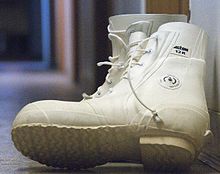Bunny boots: Difference between revisions
m clean up using AWB |
|||
| Line 24: | Line 24: | ||
==References== |
==References== |
||
http://www.bunnyboots.com/ |
http://www.bunnyboots.com/ |
||
http://www. |
http://www.mickeymouseboots.com/ |
||
<references /> |
<references /> |
||
{{footwear}} |
{{footwear}} |
||
Revision as of 10:52, 6 February 2013
This article has multiple issues. Please help improve it or discuss these issues on the talk page. (Learn how and when to remove these messages)
No issues specified. Please specify issues, or remove this template. |
Bunny Boots is the widely-used nickname for the Extreme Cold Vapor Barrier Boots (Type II) used by the United States armed forces. The liner-less bulbous boots retain warmth by sandwiching up to one inch of wool and felt insulation between two layers of rubber and are typically worn with one heavy wool sock. These boots were originally developed at the Navy Clothing and Textile Research Center in Natick, MA USA for use during the Korean War.

Originally designed for the military, such boots have become staple cold weather gear both in civilian work and recreational environments. Bunny boots are very popular in Alaska.[1]
Description
Type I
The black pairs, sometimes called Mickey Mouse boots, weigh 44 oz. (1.25 kg) apiece and are rated for temperatures down to -20°F (-28.9°C) and is made with oil/diesel resistant rubber. They are less common than the white pairs that give the boots their name.

Type II
The white boot is designed for use in extreme cold weather from -65°F (-53.8°C) . It also is a little bigger and heavier (~8 oz. (0.22 kg) per boot) than the black boot because of the extra insulation.
-
White bunny boots

Both Mickey Mouse boots and Bunny Boots have an air valve on each of the boots. These air valves must be opened prior to flying, to ensure that the air pressure differential between the walls of the boot and the outside air does not cause the boots to rupture. The Snow Shoe Rabbit, commonly found near Ft. Greely AK, is responsible for the nickname. During the fall the rabbits' fur changes color from brown to white, allowing it to blend in with its winter surroundings. As winter gets closer, more and more rabbits appear with their new white "boots", hence the name bunny boots.

References
http://www.bunnyboots.com/ http://www.mickeymouseboots.com/
- ^ Charles P. Wohlforth (22 March 2011). Alaska For Dummies. John Wiley & Sons. p. 21. ISBN 978-0-470-88871-1. Retrieved 4 April 2012.

